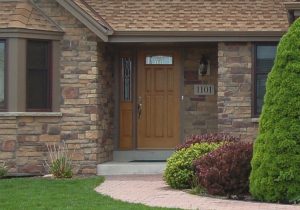 “First impressions are important because they are long-lasting, and when it comes to your home, the front door is often one of the first exterior elements that visitors notice,” said Lance Dahl, CR, Senior Sales Representative – Exterior Products with Callen in Muskego. “Why does this matter? Well, for starters, there is a direct correlation between a home’s front door color and a home’s curb appeal. Moreover, it’s a home improvement project that allows you to fully embrace your creative side and add value to your home.”
“First impressions are important because they are long-lasting, and when it comes to your home, the front door is often one of the first exterior elements that visitors notice,” said Lance Dahl, CR, Senior Sales Representative – Exterior Products with Callen in Muskego. “Why does this matter? Well, for starters, there is a direct correlation between a home’s front door color and a home’s curb appeal. Moreover, it’s a home improvement project that allows you to fully embrace your creative side and add value to your home.”
Whether you prefer to blend into your surroundings with a neutral hue or stand out with a bold shade, the color you select for your home’s front door will help set the tone for the rest of your home as well as provide a glimpse into your personal taste and style.
“A straightforward and effective approach when selecting a new color for your front door entails taking a page from the construction materials of your home and your lawn and garden areas,” Lance said. “Using classic earth tones, such as whites, creams, browns, tans, grays, greens, and even black, will not only compliment the colors in and around your home, but it can also help to add character to your home by giving it that eye-catching pop of color. In addition, natural hues are timeless.”
Remember to also consider your home’s outdoor lighting situation before making a definitive decision. For instance, a darker colored front door is ideal for a well-lit front entry, while a lighter colored front door is better suited for a dimly lit space. When a front door color is in direct contrast to the intensity of nearby lighting, the color is more accentuated, and the front door becomes a stronger focal point.
“In addition to a home’s materials, you can also assess your home’s architectural design and style,” said Lance. “For example, traditional homes tend to feature front doors with deep colors, such as dark teal, galaxy blue, royal purple, or even crimson red. Conversely, modern homes don’t shy away from exhibiting bolder, more unorthodox front door colors, such as lime or turquoise.” Beyond examining a home’s overall architecture, it may also help to refer to the specific color and style of a home’s garage door. To avoid choosing incompatible colors, consider incorporating a front door color that compliments the garage door’s color scheme, as they will work together to create high contrast and enhance a home’s overall aesthetic appeal.
If you live in a smaller home and would like nothing more than to maximize its square footage, then you’ll want to follow a monochromatic color scheme for your front door. “A simple design trick, painting your front door all one color, or using slightly different tones of that one color, will create a sizeable neutral canvas that puts the spotlight on the décor and architectural features of your home rather than the front door itself,” Lance said . “This creates the illusion that your home’s exterior is grander than it is in reality.”
Another key aspect to choosing the perfect color for your front door involves choosing the color outside. It’s well established that colors inside a home look different when exposed to natural light and the elements. “Our perception of color changes based on the amount and type of light present as well as the environment the colors are in, or more specifically, their immediate surroundings,” said Lance. “If you want to cover all your bases, affix the color samples directly to your door and view them at different times of day to see how the color reacts to varying amounts of natural light and different weather conditions. Doing so will help ensure that you’re fully satisfied with your final color selection.”
Although there is color theory and principal rules of color combination, the front door color should ultimately be a decision that best suits the homeowner and the dwelling. “If you consider yourself to be more conventional, then a natural tone would be your safest option. However, if you’re drawn to the contemporary, then a bold hue is right up your alley,” Lance said. “It’s always recommended to consider the home’s existing exterior colors and surroundings as well as your home’s architectural design prior to making your final decision, but don’t let this limit your creativity. Just be sure to make your decision after you’ve seen how your color sample reacts to natural light and the outdoors.”
Are you ready to improve your curb appeal? Call Callen today to get started.


